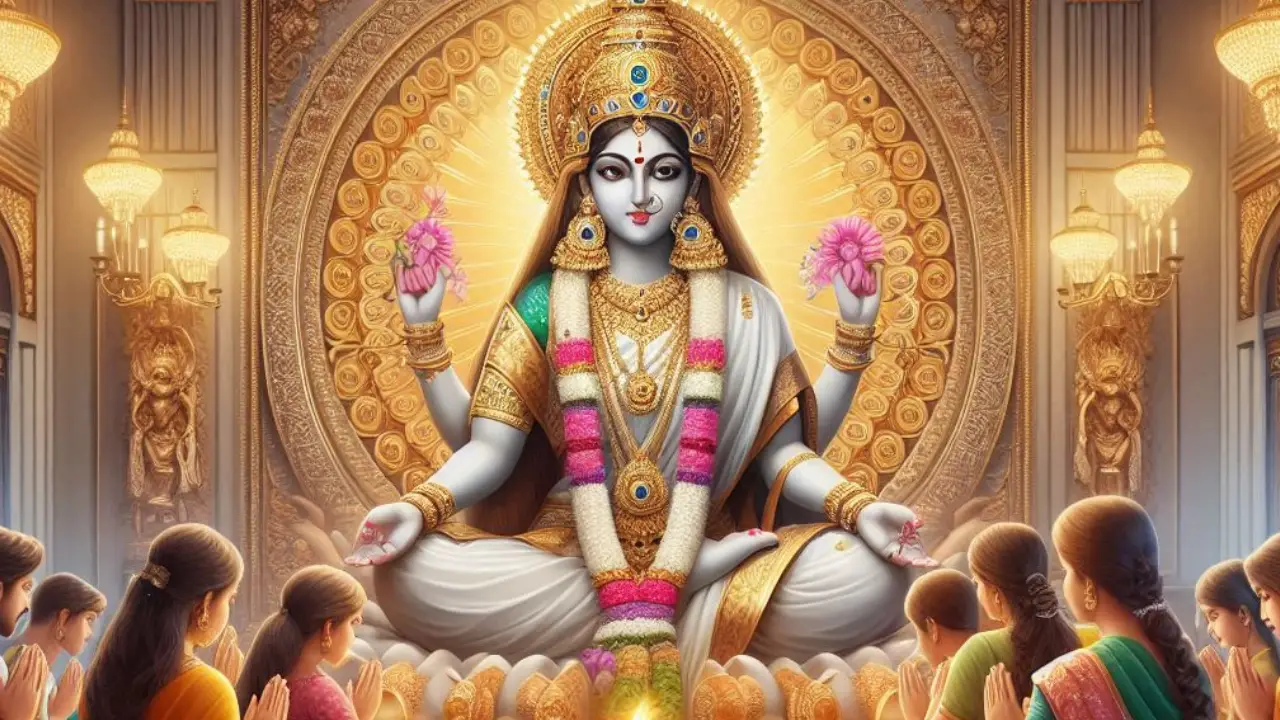Chaitra Navratri holds deep spiritual significance for millions across India. This sacred festival celebrates the divine feminine energy and its powerful influence. Beyond rituals and traditions, Goddess worship during Chaitra Navratri carries profound symbolic meanings that offer valuable life lessons.
The Symbolism Behind the Nine Forms of Durga
The nine days of Chaitra Navratri honor nine distinct forms of Goddess Durga. Each form carries unique attributes that reflect inner strength, wisdom, and courage.
1. Shailaputri – The Power of Grounding
Shailaputri, the first form, represents stability and strength. Worshiping her reminds us to stay rooted in our values, no matter the challenges. Just like a mountain stands firm against storms, inner strength helps us face hardships.
During tough financial times, grounding yourself in patience and clear thinking helps you make better decisions.
2. Brahmacharini – The Power of Self-Discipline
Brahmacharini symbolizes devotion and self-control. Her message encourages perseverance and focus on personal growth.
Students preparing for exams often find success by adopting disciplined study habits, staying calm, and focusing on their goals.
3. Chandraghanta – The Power of Courage
Chandraghanta symbolizes bravery and preparedness. Her fierce form reminds us to confront fears with confidence.
Facing public speaking anxiety becomes easier when you prepare well and adopt a positive mindset.
4. Kushmanda – The Power of Creation
Kushmanda’s glowing energy signifies creativity and positive thinking. She inspires us to nurture ideas and manifest new beginnings.
Starting a new business requires courage, creativity, and belief in your potential, much like Kushmanda’s radiant energy.
5. Skandamata – The Power of Protection
Skandamata’s motherly form represents protection and guidance. Worshiping her strengthens family bonds and promotes care for loved ones.
Parents often show this energy by guiding their children through challenging phases in life.
6. Katyayani – The Power of Justice
Katyayani symbolizes righteousness and the courage to stand against injustice. Her strength reminds us to speak the truth and uphold fairness.
Standing up for a friend facing discrimination reflects the essence of Katyayani’s powerful presence.
7. Kalaratri – The Power of Facing Darkness
Kalaratri’s intense form symbolizes overcoming negativity and fear. Worshiping her inspires inner strength to tackle life’s darkest moments.
Overcoming self-doubt often starts with embracing your weaknesses and turning them into strengths.
8. Mahagauri – The Power of Purity
Mahagauri represents inner clarity and purity of heart. Worshiping her encourages forgiveness, peace, and renewal.
Letting go of past grudges can help restore peace in relationships, reflecting Mahagauri’s cleansing energy.
9. Siddhidatri – The Power of Fulfillment
Siddhidatri symbolizes wisdom and spiritual enlightenment. Worshiping her helps develop patience, contentment, and inner joy.
Practicing meditation brings clarity and calmness, which aligns with Siddhidatri’s blessings.
Symbolic Meaning of Rituals of Goddess worship during Chaitra Navratri
Beyond goddess worship, the rituals themselves carry powerful symbolism that can shape our mindset and behavior.
1. Lighting the Akhand Jyoti
The continuous flame represents unwavering faith and hope. Keeping this flame alive reminds us to maintain positivity during tough times.
People battling illness often draw strength by believing in recovery and focusing on small victories.
2. Offering Fresh Flowers
Flowers symbolize gratitude, purity, and devotion. Each petal reflects a promise to improve ourselves.
Practicing gratitude daily — like writing down three good things — cultivates a positive mindset.
3. Fasting for Self-Control
Fasting represents discipline, patience, and mental strength. It teaches us to detach from excess and focus on spiritual growth.
Many professionals who practice intermittent fasting claim improved focus and better self-control.
4. Reciting Mantras
Chanting mantras generates positive vibrations that calm the mind. These sacred sounds uplift the spirit and create mental clarity.
Repeating a powerful mantra like “Om Dum Durgaye Namaha” can reduce anxiety and boost self-confidence.
The Role of Colors in Chaitra Navratri
Each day of Navratri is linked to a specific color, symbolizing distinct energies.
Day 1 – Yellow
Yellow represents joy and positivity. It brings warmth and enthusiasm, creating a cheerful start to Navratri. Wearing yellow invokes feelings of hope and new beginnings.
Day 2 – Green
Green signifies growth, renewal, and fertility. This color encourages balance and harmony, promoting inner peace during prayers.
Day 3 – Grey
Grey symbolizes strength and resilience. It reminds devotees to stay grounded and composed, no matter the challenges.
Day 4 – Orange
Orange stands for energy and courage. It inspires confidence and determination, strengthening one’s faith and focus.
Day 5 – White
White represents purity and peace. Wearing white enhances spiritual clarity and encourages calmness during meditation.
Day 6 – Red
Red signifies power and passion. It symbolizes strength and is often linked to the fierce form of Goddess Durga.
Day 7 – Royal Blue
Royal blue embodies stability and depth. It encourages wisdom and clarity, guiding you toward better decision-making.
Day 8 – Pink
Pink reflects love and compassion. It invites harmony and affection, fostering positive connections during celebrations.
Day 9 – Purple
Purple represents ambition and power. It encourages spiritual growth and enlightenment, ending Navratri on a deeply reflective note.
Wearing these colors aligns your energy with the goddess’s blessings.
How to Apply These Teachings in Daily Life
Goddess worship during Chaitra Navratri isn’t limited to temples. You can apply its wisdom to improve your mindset and relationships.
Embrace self-discipline by setting daily goals.
Develop inner courage by confronting your fears.
Cultivate patience during moments of frustration.
Practice gratitude for blessings, big or small.
Offer kindness to those facing hardships.
A Call to Embrace Inner Strength
Goddess worship during Chaitra Navratri isn’t just about rituals. It’s a powerful reminder of your inner strength, courage, and potential. Each goddess reflects qualities that live within you. By connecting with those energies, you can overcome challenges, find purpose, and live with greater peace.
What lessons have you drawn from Chaitra Navratri’s symbolism? Share your thoughts in the comments below!

